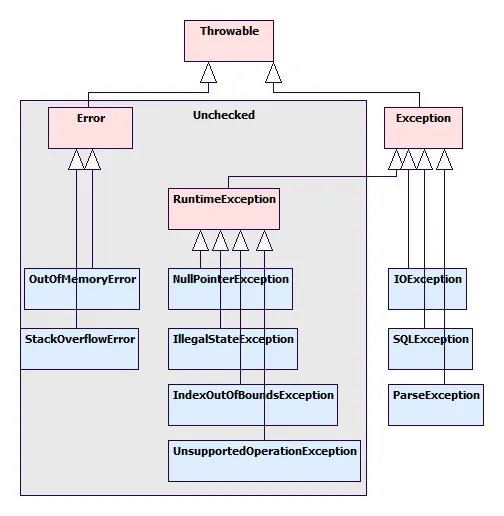我知道Error[运行时错误]和Exception之间的区别。{参考JAVA语言}。 但致命错误和异常是相同的还是不同的?或者在Java中根本没有致命错误这个概念? 我在谷歌上搜索,但结果令人困惑。
阅读Java异常教程。
如果需要简短的解释,您可以使用此小指南。查看带有Java异常层次结构(红色)和每个类别中的几个示例(蓝色)的类图。
Throwable:Java异常机制可抛出(和捕获)的所有内容的共同祖先。
Error:您可以将Error视为所谓的“致命异常”。通常甚至没有意义尝试恢复应用程序。 OutOfMemoryError或StackOverflowError是此类致命错误,你几乎无法在应用程序内做任何操作。
不要捕获Error,让程序崩溃并在外部解决问题。
RuntimeException:应该用于大部分程序员错误(请参见以下示例),例如未处理的空指针取消引用、未满足方法合同等。
虽然有一些技术将所有异常捆绑到RuntimeException中,并在业务代码外部处理它们(通常使用AOP),但通常出现RuntimeException的情况意味着您应该让程序崩溃并修复其源代码。
/**
* Does something with s.
* @param s The input string
*/
public void badlyDesignedMethod(String s) {
// Here the programmer omitted to check s against null
int i = s.length();
...
}
/**
* Does something with s.
* @param s The input string; must not be null
*/
public void betterDesignedMethod(String s) {
if (s == null) {
throw new IllegalArgumentException("The parameter s must not be null!");
}
int i = s.length();
...
}
public void caller() {
badlyDesignedMethod(null); // will throw NullPointerException
// It is the fault of the programmer of badlyDesignedMethod()
// as they have not specified that the parameter must not be null.
betterDesignedMethod(null); // will throw IllegalArgumentException
// Now it is the fault of the programmer of caller()
// as they violated the contract of betterDesignedMethod()
// which DOES tell them that the parameter must not be null
}
Error和RuntimeException都是未检查异常,这意味着方法无需声明它们会抛出异常,调用者也不需要捕获它们,即无需使用try-catch块来包围调用。
其他异常(从Exception继承而来,而不是从RuntimeException继承):这些异常应该被声明(throws...)并且需要被捕获(try-catch),通常用于从方法向其调用者传递有用信息的情况,例如数据库不可用、文件无法打开等等。
这些异常需要由您的代码处理。它们是“预期异常”,与“运行时异常”相比属于“预料之中的异常”。
public void doSomethingWithFile(String fileName) throws IOException {
if (/* file is not accessible */) {
throw new IOException("File " + fileName + " is not accessible!");
}
...
}
public void caller() {
try {
doSomethingWithFile("/home/honza/file.txt");
}
catch (IOException e) {
// handle the fact that the file is not accessible
return;
}
...
}
2015-09-28 15:21:48,222 Thread-4 FATAL Unable to register shutdown hook because JVM is shutting down. java.lang.IllegalStateException: Cannot add new shutdown hook as this is not started. Current state: STOPPED
at org.apache.logging.log4j.core.util.DefaultShutdownCallbackRegistry.addShutdownCallback(DefaultShutdownCallbackRegistry.java:113)
at org.apache.logging.log4j.core.impl.Log4jContextFactory.addShutdownCallback(Log4jContextFactory.java:271)
at org.apache.logging.log4j.core.LoggerContext.setUpShutdownHook(LoggerContext.java:240)
这表示某个操作导致了错误或异常,并且开发人员使用FATAL级别的日志框架记录了该错误或异常。消息可以在任何级别记录。
例如,Log4J提供许多日志级别:OFF、FATAL、ERROR、WARN、INFO、DEBUG、TRACE、ALL。
http://logging.apache.org/log4j/2.x/log4j-api/apidocs/org/apache/logging/log4j/Level.html
仅仅为了更加混淆,还有一种叫做ERROR的日志级别。
总之,FATAL异常与FATAL错误: FATAL是异常或错误对象记录的日志级别,并不影响发生的异常或错误,但当开发人员以FATAL级别记录时,它是用来引起注意并引起反应的。 根据Log4J关于何时记录FATAL级别的文档, “一个严重的错误将会阻止应用程序继续运行。”
原文链接

Error和Exception之间的区别吗?因为有一个RuntimeException,所以如果你认为Error在某种程度上是特定于运行时的,那么你就错了。 - Kayaman